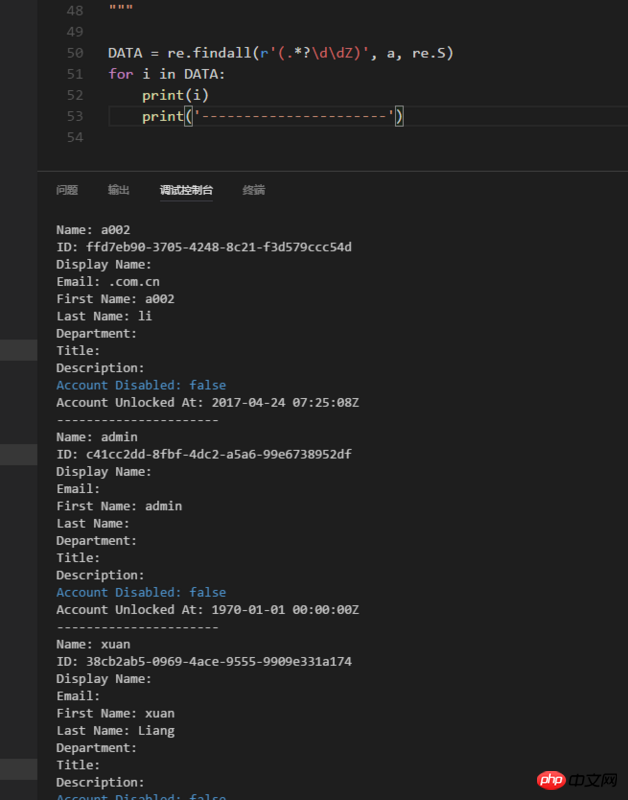- Gemeinschaft
- Lernen
- Tools-Bibliothek
- Freizeit
Heim > Fragen und Antworten > Hauptteil
Name: a002
ID: ffd7eb90-3705-4248-8c21-f3d579ccc54d
Anzeigename:
E-Mail: .com.cn
Vorname: a002
Nachname: li
Abteilung:
Titel:
Beschreibung:
Konto fähig: false
Konto freigeschaltet am: 24.04.2017 07:25:08Z
Name: admin
ID: c41cc2dd-8fbf-4dc2-a5a6-99e6738952df
Anzeigename:
E-Mail:
Vorname: admin
Nachname:
Abteilung :
Titel:
Beschreibung:
Konto deaktiviert: false
Konto freigeschaltet am: 1970-01-01 00:00:00Z
Name: xuan
ID: 38cb2ab5-0969-4ace-9555-9909e331a174
Anzeigename:
E-Mail:
Vorname: xuan
Nachname: Liang
Abteilung:
Titel:
Beschreibung:
Konto deaktiviert: false
Konto freigeschaltet am: 04.05.2017 01:44:24Z
Name: a001
ID: 6b45403d-4654- 4e0a-9145-91405d67aa3b
Anzeigename:
E-Mail: com.cn
Vorname: a001
Nachname: li
Abteilung:
Titel:
Beschreibung:
Konto deaktiviert: false
Konto freigeschaltet am: 24.04.2017 10 :09:33Z
如上面的文段,按不同的Name来区分不同的用户,最终可以把不同用户的信息分别存入mysql?
淡淡烟草味2017-05-18 10:53:32
# coding: utf8
from collections import defaultdict
file_name = '1.txt'
result = defaultdict(dict)
with open(file_name) as f:
user_name = ''
for i in f:
tmp = i.strip().split(':', 1) # 只切割一次
if len(tmp) == 1:
# 对应的键没有值, 用空字符补充
tmp.append('')
key, value = tmp
if i.startswith('Name'):
user_name = key
continue
if user_name:
result[user_name][key] = value
print result # 用户结果集合字典, 可以遍历这个插入数据库, 也能在运行中插入, 任君选择某草草2017-05-18 10:53:32
用正则分割,再根据用户名分到一组
DATA = re.findall(r'(.*?\d\dZ)', a, re.S)
for i in DATA:
print(i)
print('----------------------')
